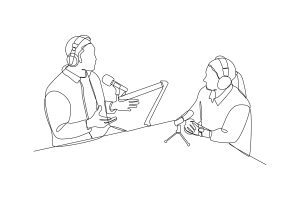Hanging out at our company booth at the Bridge Conference in Washington D.C. last week, I noticed an almost overwhelming trend amongst the other exhibitors. This is an annual event that explores the intersections between fundraising and marketing in the nonprofit world; the attendees are largely executives from charitable organizations looking for ways to spread their message and secure more donations, and the vendors are all selling services and/or software that they believe can help do that. Strolling around and checking out the other booths, I saw that the vast majority of the solutions on offer were about efficiently upscaling the size of a donor pool: using AI and other up-to-date technologies to identify potential donors more quickly, accurately, and in greater quantities. It was striking, though, how few of them were offering ways to connect with these donors more deeply.
We’ve been working with nonprofit organizations for as long as we’ve been a company, more than 12 years now. The reason that has been such a good fit is that podcasting offers something uniquely valuable: a way to build really meaningful long-term relationships between your organization and both your current donors and the people who will become donors in the future.
This is crucial because fundraising is really the most emotional kind of sales. There is no personal, practical value to a donation; it doesn’t cook your dinner or fly you to Tahiti. A charitable gift won’t mow your lawn, train your dog, or store your underwear. Your hair will be the same length after you press “send” as it was beforehand. Somehow, fundraisers have to convince people to use some of their money not for fulfilling their own immediate personal needs and wants, but instead giving it over for the benefit of others at some point in the future. This is no small feat. The way they do it is by providing something no meal, haircut, vacation, or home improvement can: the feeling that you’re doing good in the world. This is a lovely feeling, and it turns out that people will pay handsomely for it if you can provide it in large enough doses.
To provide this feeling with every donation, an organization has to successfully convey three things: first, the value of their mission—the existence and importance of the problem they are set up to solve. Second, their expertise—evidence that their particular solution is the one that will work. Third, track record—the solution has been deployed successfully and will be again and again until the problem is no more. Succeed in communicating those three points to people who care and have money, and they will flock to give (and receive the accompanying boost of dopamine).
The trick, though, is that you can’t convince people of any of this just by telling them. Tell people of the existence of a problem that they can’t see immediately in front of them, and their first response will be skepticism. Tell people of your own expertise and accomplishments and they’ll think you’re bragging, and no one feels good giving anything to a braggart. No, to get people to feel your organizational value down in the deep places in their hearts from which donations flow, you have to carefully place the information in the world in a way that they will find it on their own. Nothing feels more truthful than a credible piece of information you discover accidentally. The answer, then, is content creation. Putting the stories people need to hear out into the world in a way that they will find, understand, and feel.
But what kind of content? To be truly effective, you need a stream of media that does what you need and also gives the audience what they need. It can’t just accurately demonstrate your organization’s effectiveness, it also has to be entertaining and useful. For audiences to return to the feed over and over again it also has to strike the right balance between consistency and variety. It has to be accessible to a broad audience. It has to be sufficiently long-form to properly capture the subtlety of your organizational vision, it has to be produced at a high enough level of quality, both technically and creatively, that people will enjoy spending time with it, and all of this has to be done for a price that is reasonable and sustainable.
This is a lot of hurdles to jump, and of all the many forms of media you might invest in creating, there is only one that can clear all of them. Videos are either extremely short, infrequently released, prohibitively expensive, or of embarrassingly low quality (you can choose which). Live events are totally inaccessible to anyone not nearby or able to travel. Webinars are only really interesting to people watching live, and even then the audience experience is uncomfortably close to the endless Zoom calls that have eaten all of our work lives. Blogs and e-blasts (he types with a certain irony) are rarely well-written enough to be exciting, and only accessible to people who have time in their day to sit and read them. White papers are almost always as dull as a plastic spoon. Really, the only sensible option is a well-produced audio podcast. Versatile, intimate, unapologetically long-form, undeniably cost-effective, and immediately accessible to anyone with a phone, worldwide, it does everything a nonprofit organization needs to inspire awareness of the urgency of their mission and confidence in their expertise.
(David Hoffman is the Founder & Principal of CitizenRacecar)





